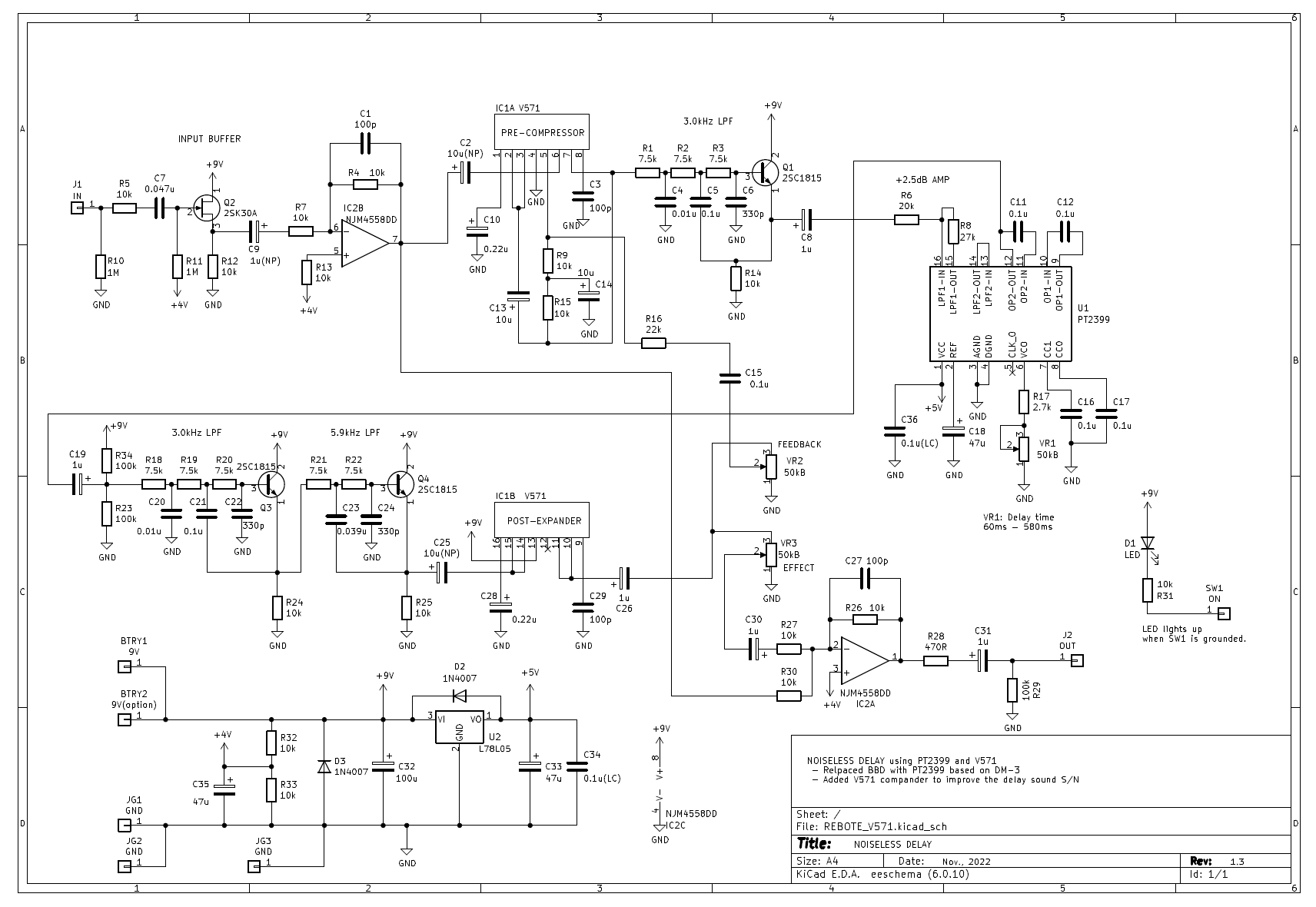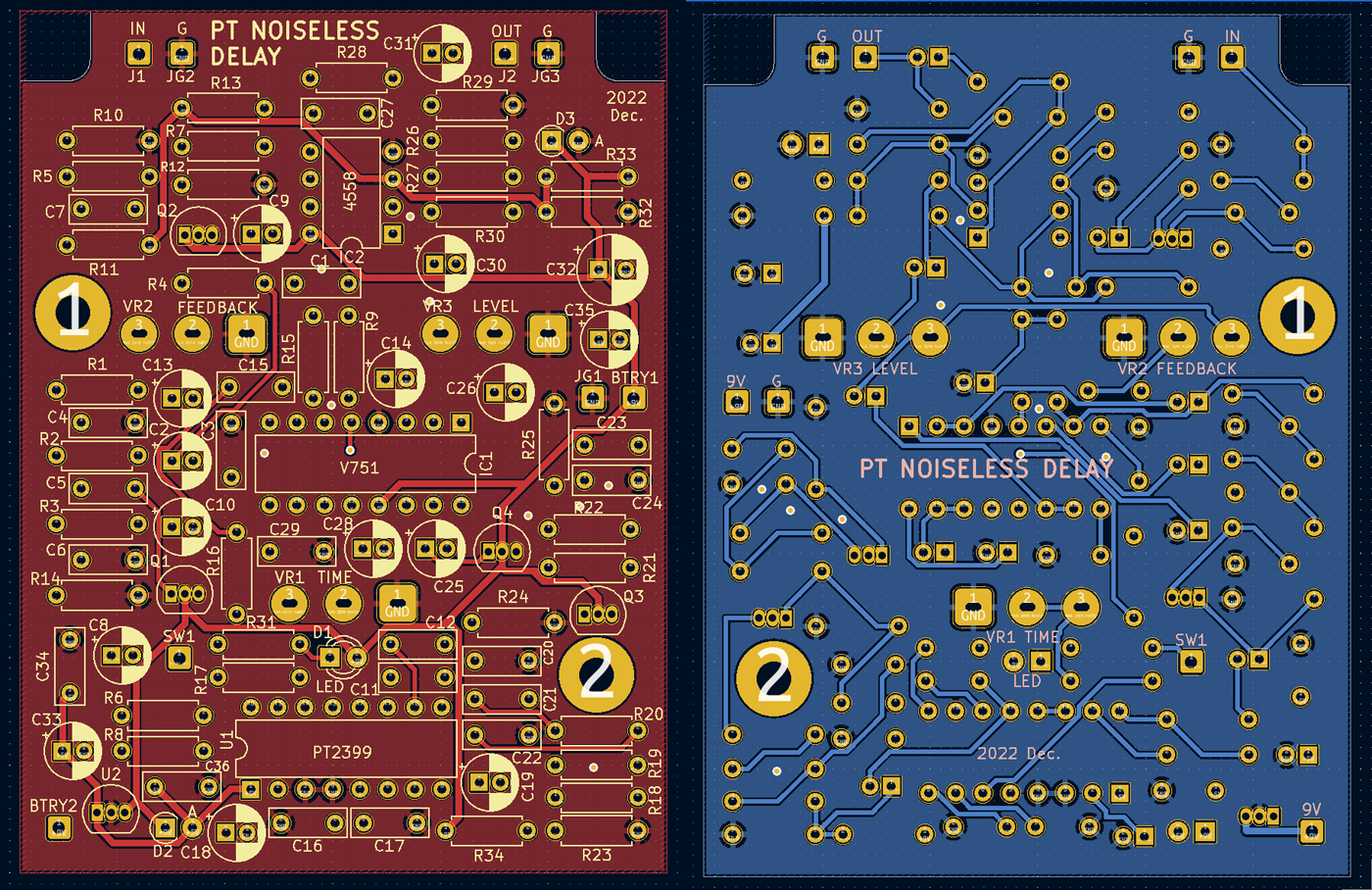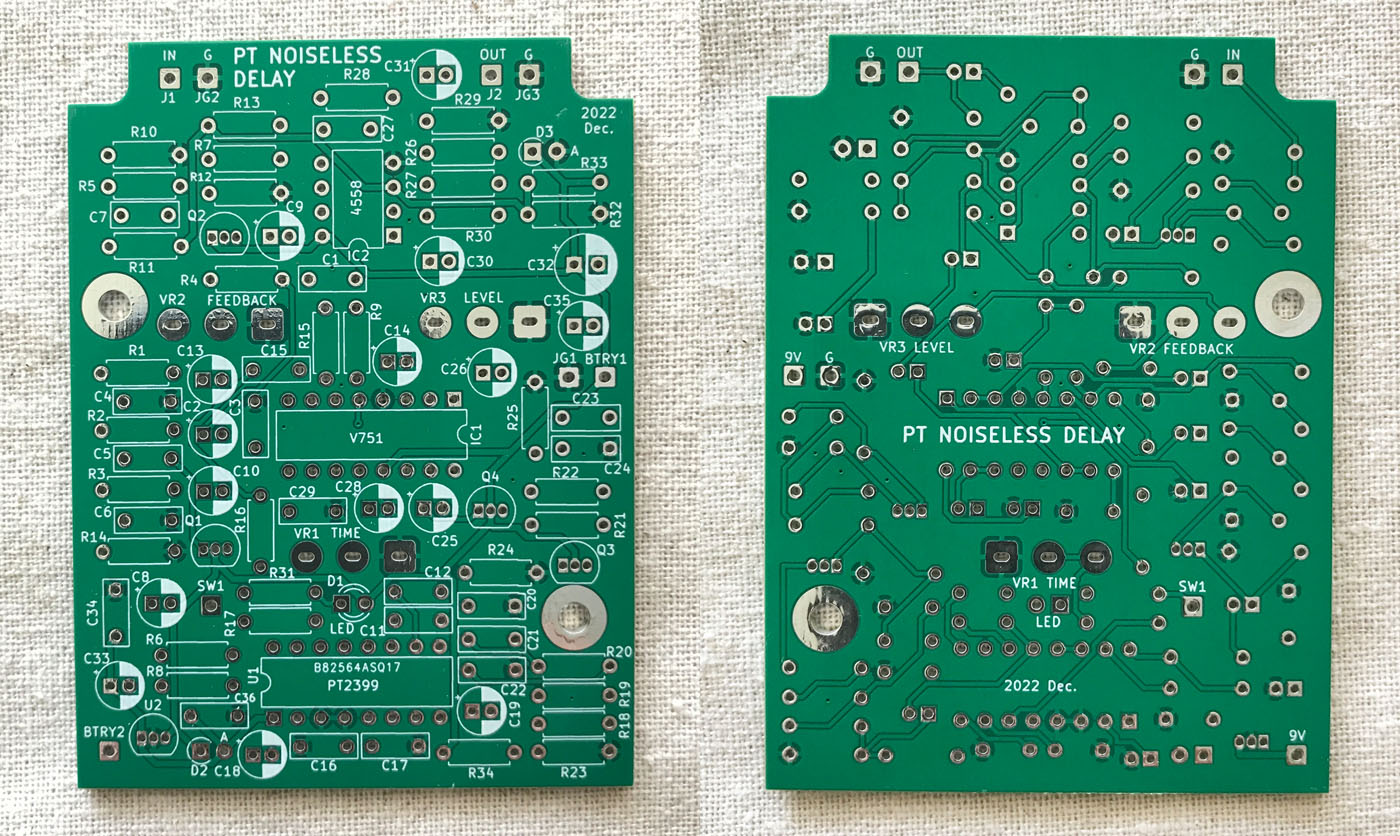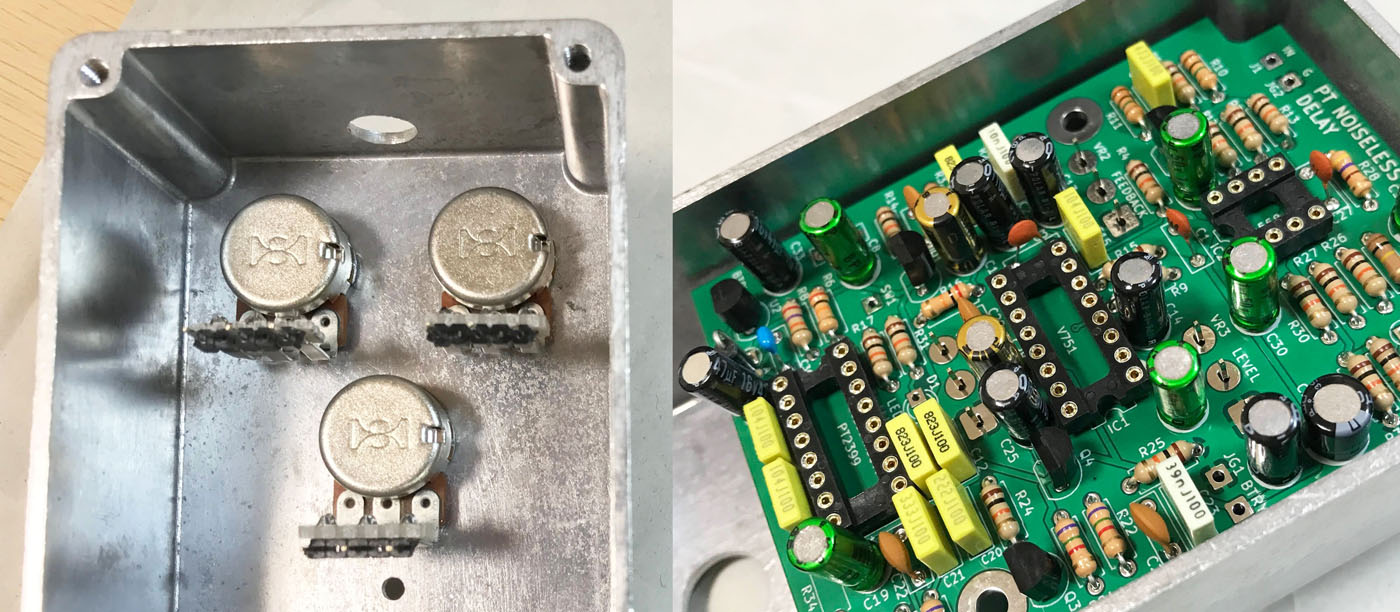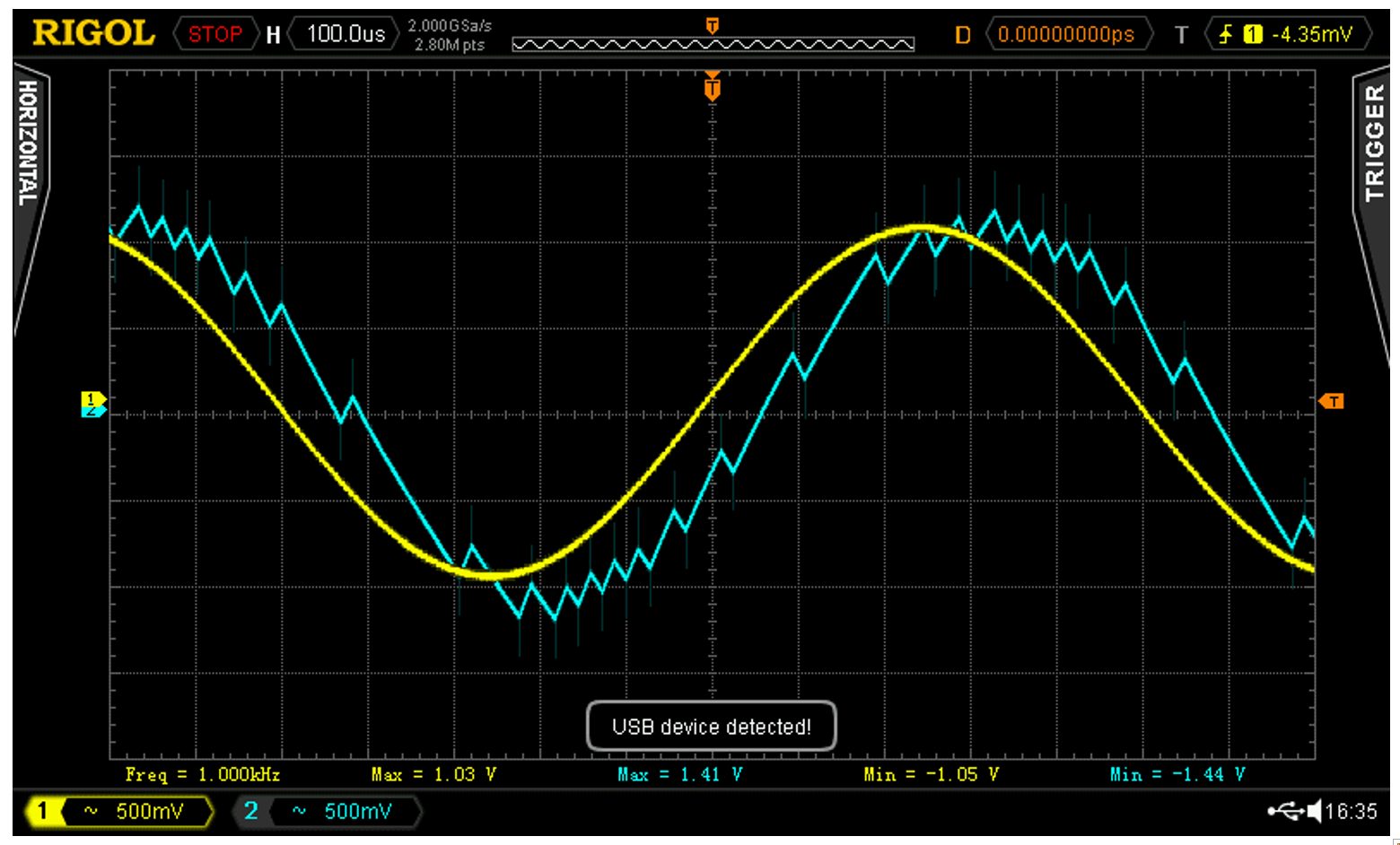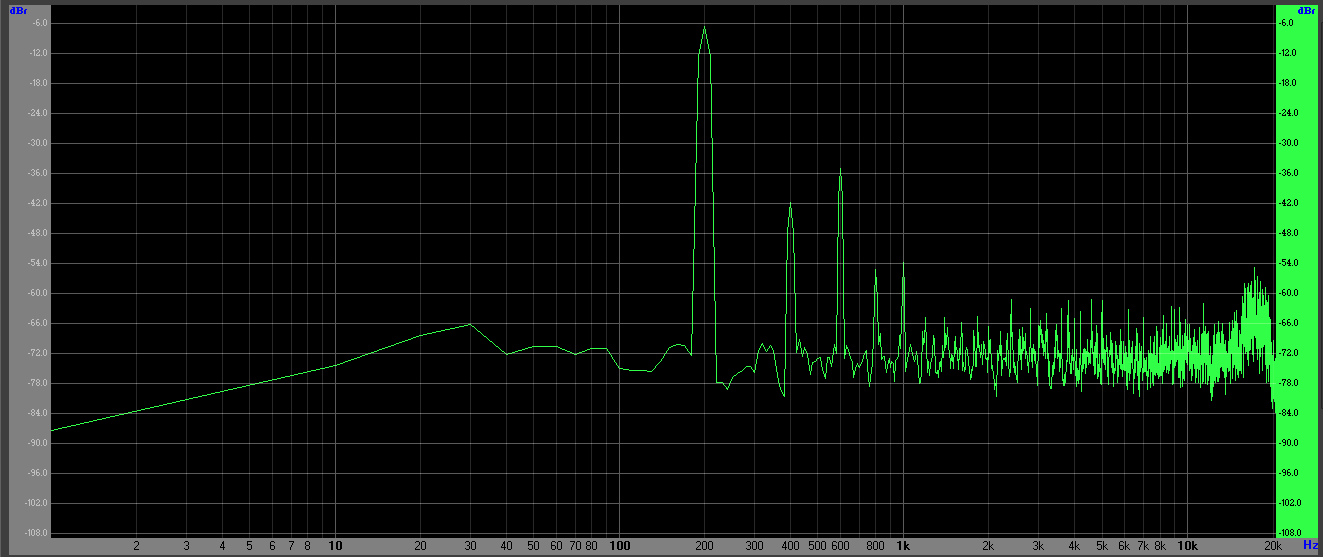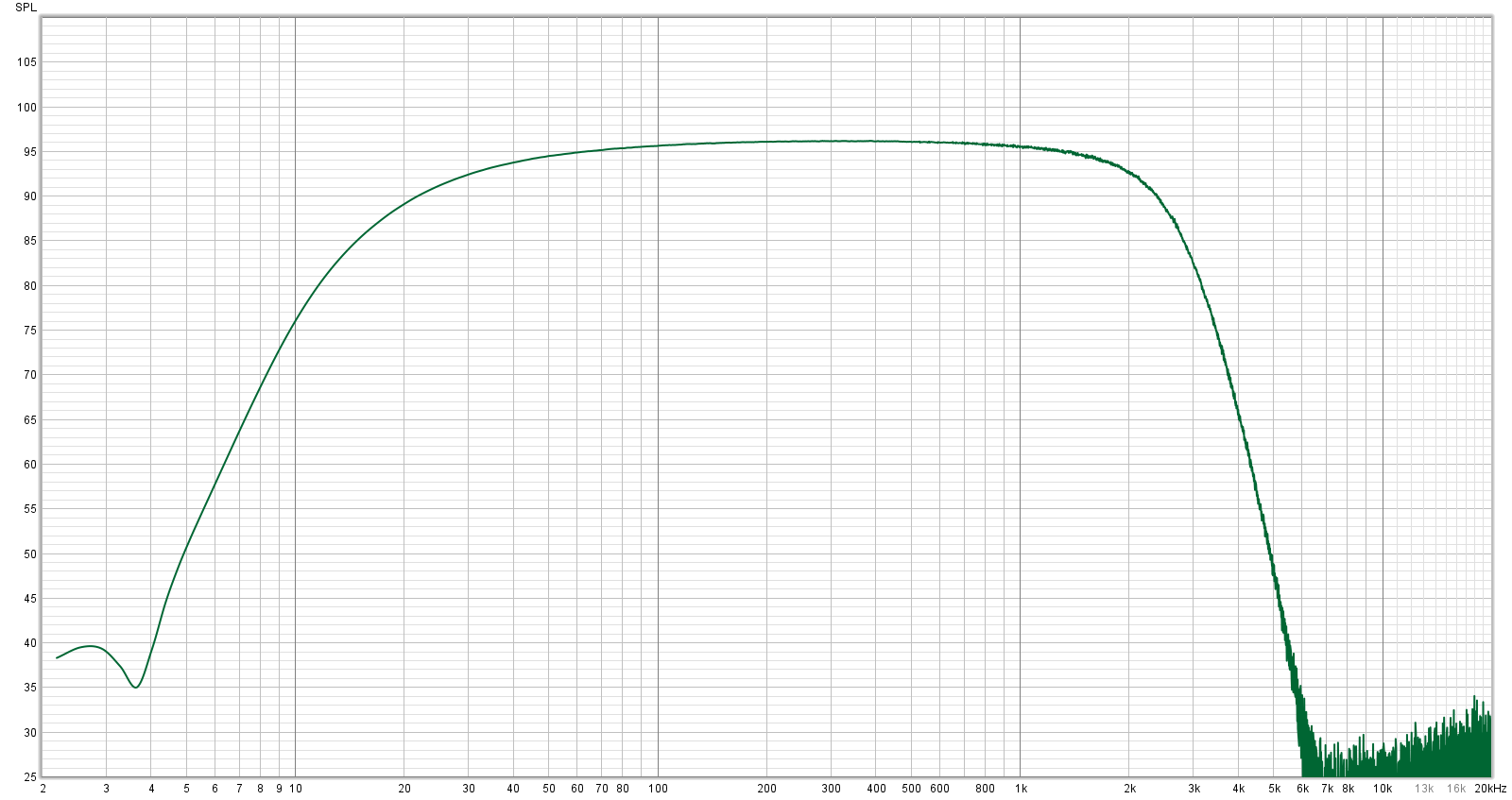Noiseless! Self-made delay pedal using handy PT2399
Self-made Guitar Effect Pedals
Explore the articles to learn more about your favorite effect pedals.
|
Experience in creating delay pedals using BBD
Based on the circuit of BOSS DM-3, I made three analog delay pedals using BBD. I like them a lot because they create analog "warm" delay sounds.
However, there are many adjustment points, and it may be difficult to make your own. Getting the best fit may be difficult without any oscilloscope.
Added noise reduction to the echo IC "PT2399"
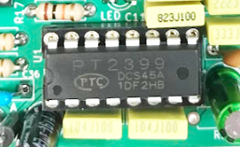 The PT2399 is popular as an easy-to-use delay IC. It has HiFi capability like a karaoke echo. The internals are digitally processed, but recently the PT2399 is used in delay pedals from various companies to produce an analog-like sound instead of BBD.
The PT2399 is popular as an easy-to-use delay IC. It has HiFi capability like a karaoke echo. The internals are digitally processed, but recently the PT2399 is used in delay pedals from various companies to produce an analog-like sound instead of BBD.
The biggest advantage of this delay IC is that there are no adjustment points like when using a BBD, and it works without fail once the circuit is assembled.
You can find a lot of examples using this delay IC on the Internet, but it seems that there are no examples that focus on noise reduction. Therefore, I added a compander (V571 made by Coolaudio) used for noise reduction of BOSS DM-3 and made a pedal that eliminates the noise of the delay sound.
Sound characteristics of the compander (V571)
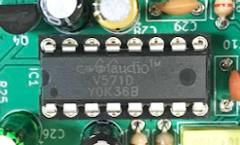 According to my own experience with the BOSS DM-3, when the delay sound is passed through a compander (V571), the expander in the latter stage acts like a noise gate, and it seems that only the part where the delay sound is coming out is cut out. . I think it will sound similar to the old dbx and Dolby NR used in cassette decks.
According to my own experience with the BOSS DM-3, when the delay sound is passed through a compander (V571), the expander in the latter stage acts like a noise gate, and it seems that only the part where the delay sound is coming out is cut out. . I think it will sound similar to the old dbx and Dolby NR used in cassette decks.
This will result in noise reduction. When the delay sound is silent, the expander gate is closed and the noise emitted by the delay IC is completely eliminated. I think you can probably get a S/N of 70dB or more, which is enough for a guitar pedal.
This time, I used the PT2399 to create a delay pedal that is close to the sound output of the DM-3 and does not require adjustment.
About the circuit
The circuit has a configuration in which the BBD delay circuit of DM-3 is replaced with PT2399. The PT2399 has built-in operational amplifiers used for the LPF before and after the delay IC, but it is inconvenient to insert a compander, so they are not used this time. Instead, I added an LPF that uses a transistor modified from the DM-3 circuit.
Input operational amplifier is not used as LPF. I use it for gain adjustment (+2dB amplifier) to achieve the "oscillation effect" when FEEDBACK is increased.
Purchasing parts
I bought the parts this time at "Garrettaudio". However, since the noise reduction chip "V571" was not handled, I purchased only this part at "Akizuki Denshi Tsusho" in Akihabara.
Also, the PCB is designed so that the pots can be mounted directly on the PCB, so I used the long lead type for the three pots sold by Garrettaudio.
Electrolytic capacitors require attention to polarity. There are non-polar types of electrolytic capacitors. I use non-polar electrolysis for all signal lines other than the power supply. Prices are almost the same.
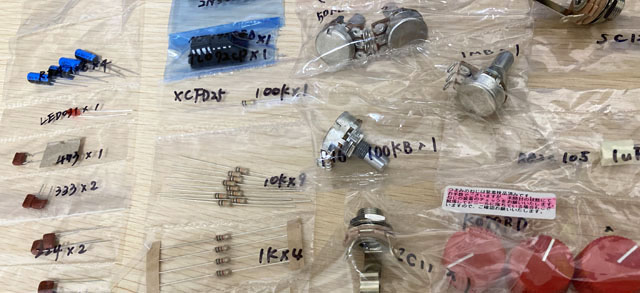
Design PCB with KiCAD
I used "KiCAD" to design a double-sided PCB. This time, I used a through-hole component (THT) instead of a surface mount component (SMD) for easy creation. For the parts that are not available in the standard library, such as the BBD and pod terminals, I created the footprints (part shape data) myself.
Two 3.2mm holes for mounting spacers to fix it to the enclosure.
Another advantage of double-sided PCBs is that solid-earth can improve noise performance.
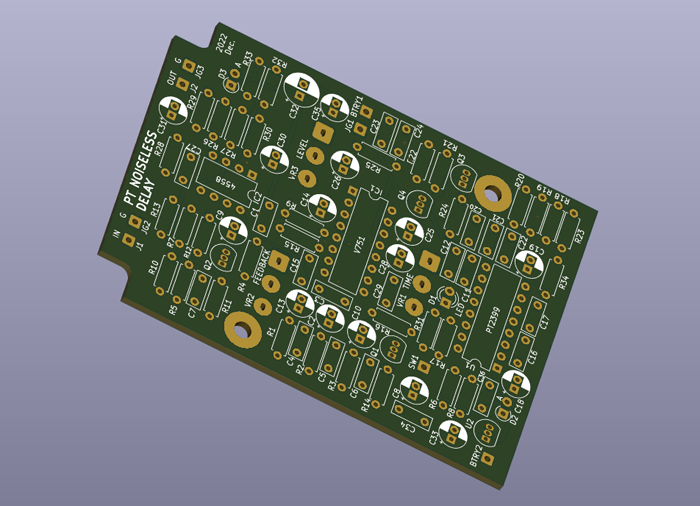
KiCad PCB design data
The PCB data created using "KiCad (Windows 64-bit) Version: (6.0.4), release build" is provided. The ZIP file contains the schematic, board design data, and original component data. Please read the terms of use and disclaimer in the attached "readme.pdf" before using this data.
Printed circuit board manufactured by "PCB gogo"
For printed circuit board manufacturing, I placed an order with "PCB gogo", which performs 24-hour express manufacturing at a standard price. It can be created simply by converting the data designed in KiCad into Gerber data and sending it via the web. Including the delivery time of the international courier service (OCS) from Shenzhen, China, it arrived in one week after the online submission. The cost is only $21 including shipping.
Component mounting on board
Soldering the components is one of the fun parts of making an effects pedal. This time, there are many parts on the printed circuit board, so I was satisfied with making it.
Since the printed circuit board has through holes, it is difficult to remove the parts once they are soldered. I carefully checked constants such as resistors and was careful not to make a mistake.
Arrangement in the case and processing of three pods
This delay pedal uses 3 pots (50kB). When I made the first unit, it was designed to connect the pod to the board with wires, but this time I designed the board so that the terminals of the pot can be directly connected.
I use HAMMOND's "1590N1" for the enclosure. To fit in this enclosure, you need to place the phone jack between the board and the bottom of the enclosure as shown in the cross section below. Therefore, I attached the pot on the back side of the board and processed the lead of the pot so that there was a space of about 20mm for placing the phone jack.
Specifically, I connected the lead of the pot and the L-shaped pin header with a universal board to make the lead longer. In this production, I used a special pot with long leads that I purchased from Garettoaudio, but I think that it is possible to use a pot with normal lead lengths by extending it with a universal board and an L-shaped pin header.
Enclosure drilling
Assumed placement in enclosure
The installation in the enclosure (HAMMOND 1590N1) assumes the following arrangement. If you use parts up to 11.5mm in height for electrolytic capacitors, you can fit in the height of the pot by setting the height to 20mm. If you don't have enough enclosure height, you can wire the pots together.
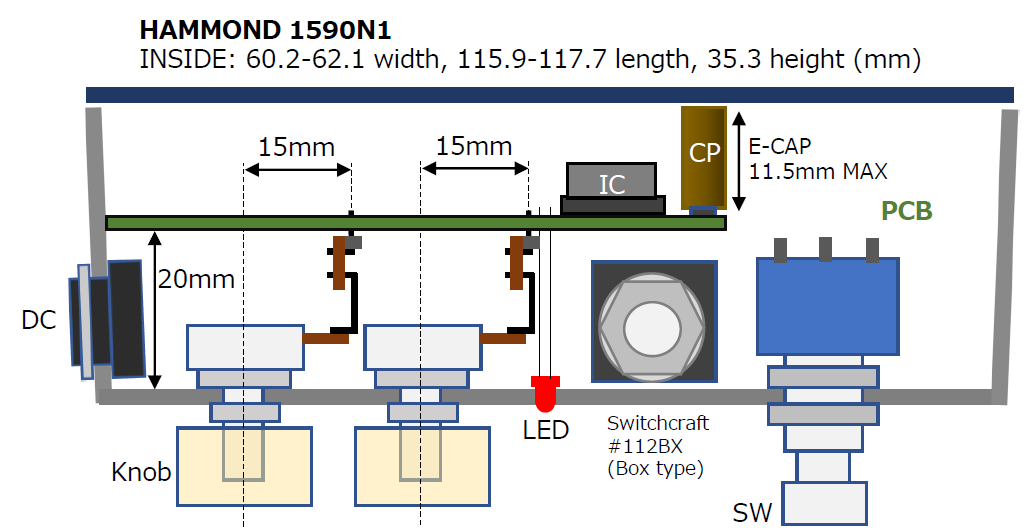
Holes suitable for pots and LEDs mounted on the board
Since the pots and LEDs are mounted on the board this time, it is necessary to drill holes according to the position of the components on the PCB. In particular, the position of the hole in the pot was determined by considering the position of the terminal on the board and the position of the rotating shaft.
The lead-processed pot has a 15mm gap between the lead soldering hole and the rotary shaft of the pot, so I decided the hole position in consideration of this. The LEDs are based on the LED mounting position on the board.
- Tips for drilling holes in the case using a hand drill
I soldered the pots to the board after I finished drilling the holes. First, I temporarily fixed the pots and jacks, checked that the leads of the pots could be passed through the holes in the board, and then soldered the pots.
At this time, I was careful not to touch the jack under the board and the soldering surface on the back side of the board.
Operation check
Adjusting the Delay FEEDBACK Gain Constant
The PT2399 has built-in op-amps for the LPF, but they are not used in this circuit to insert companders. The PT2399 has a gain of 0dB because it outputs the same level of delay sound as the input. The gain of the delay's FEEDBACK loop must be greater than 0dB, because without some gain it cannot create the "oscillating effect" typical of analog delay pedals.
Therefore, I used the op amp for the input LPF as a +2dB gain amplifier. This creates an oscillating effect when the FEEDBACK knob is turned near maximum.
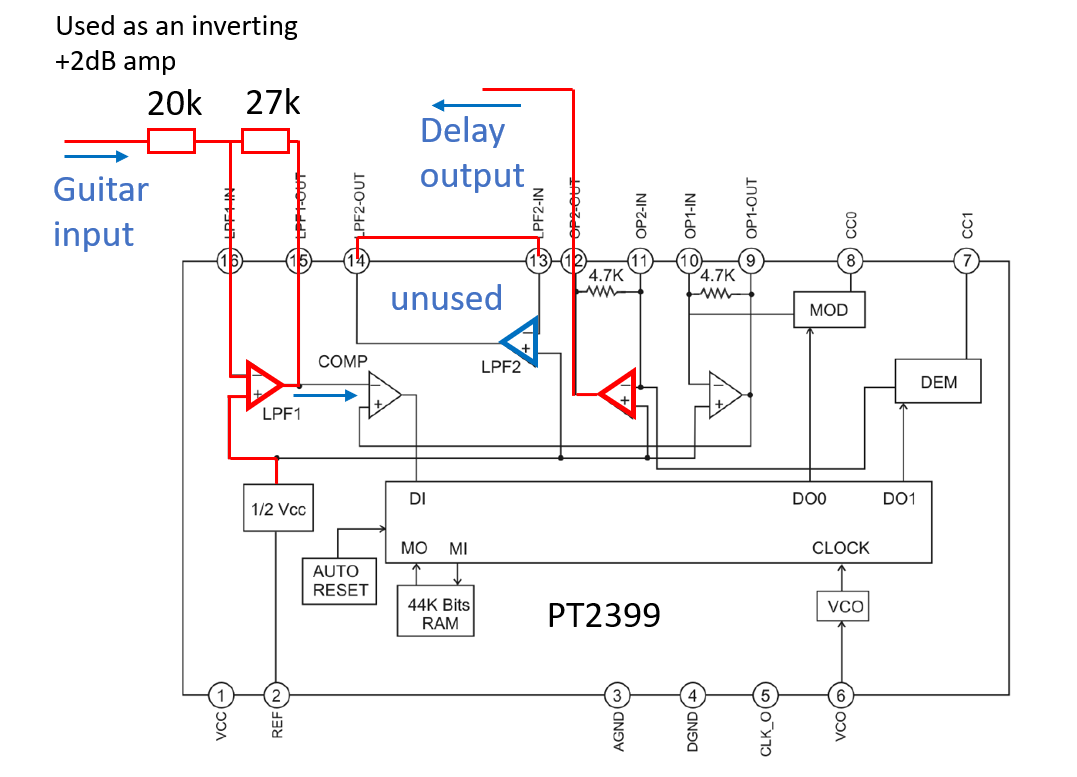
PT2399 AD/DA modulation scheme
AD/DA conversion of PT2399 is not a method driven by a constant clock like BBD, but a method called "Adaptive delta modulation (ADM)". "Delta" means "difference, amount of change", and this method converts the amount of change in signal level into pulse width (PWM). This method increases the pulse width when there is a large level change, and decreases the pulse width when there is little change. Therefore, the frequency of the pulse noise that leaks into the signal is constantly changing.
The output of the PT2399 (pin 12) is shown below with an oscilloscope (blue waveform). You can see that the period of the saw-like waveform is not constant.
The frequency characteristics (measured with a free Visual Analyzer) of the PT2399 output (12th pin) when a sine wave of 200Hz is input are as follows. You can see that the AD/DA quantization noise is distributed over a wide range and looks like white noise. (The peaks at 400Hz and 600Hz are harmonic distortion components, so they are not AD/DA noise.) When the delay sound repeats by FEEDBACK, the delay sound and noise gradually increase.
LPF constant adjustment
The calculation of the LPF constant was done on the site of "OKAWA Electric Design". The LPF of this pedal is made with an emitter follower buffer with an NPN transistor. This page has an op amp circuit, but the same constants apply to transistors as well.
First stage: Sallen-Key third-order low-pass filter (Q1: 3.4kHz)
Second stage: Sallen-Key 3rd-order low-pass filter (Q3: 3.4kHz) + Op-amp positive feedback low-pass filter (Q4: 5.9kHz)
The graph below shows the frequency characteristics of the delay line (measured with the free software "REW"). A filter that cuts off frequencies above 3 kHz is used, aiming for the sound of an analog delay.
Input test signal
I removed the PCB from the enclosure and used a breadboard to connect the input and output jacks to the PCB and tested. For the test signal, I used free PC software "WaveGene(Japanese ver)" to generate a 200Hz sine wave, output it from the audio interface (Steinberg UR22mkII), and input it to the PCB.
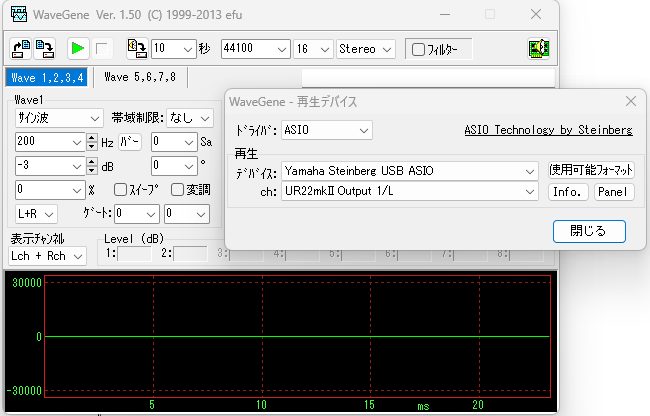
Sound sample
The recording environment is as follows. The delay time is set to the longest (approximately 580ms) and the feedback is set to be long.
In the "high tone" and "low tone" single note samples, you can hear how the repeat sound decays. When the delay time is set to the longest 570ms, a metallic sound like digital aliasing distortion is heard. Below 400ms, this noise is almost unnoticeable.
In the "low tone" sample, the V571's post-expander acts like a noise gate, cutting out only the delayed sound. Even if the repeat sound becomes muddy and noisy, you can recognize that the S/N of the silent part is good.
With “Solo Phrase,” the phrase can be heard clearly
Recording environment:
Guitar (Les Paul) -> Self-made noise reduction -> Self-made BB-Preamp (distortion) -> Self-made analog delay (this machine) -> Self-made cabinet simulator -> UR22mkII -> DAW (Studio One)
![]() PT2399 580ms sample: single high tone (MP3)
PT2399 580ms sample: single high tone (MP3)
![]() PT2399 580ms sample: single low tone (MP3)
PT2399 580ms sample: single low tone (MP3)
![]() PT2399 430ms sample: Solo phrase, a lot of delay sound (MP3)
PT2399 430ms sample: Solo phrase, a lot of delay sound (MP3)
(Reference) Comparison with BBD delay sound
Below are analog delay samples using BBD with a delay time of 600ms. Listen and compare with the PT2399 above. For more information on BBD analog delay, see:
Full analog 600ms delay pedal with two BBDs
![]() BBD 570ms Sample: High Tone Single Note (MP3)
BBD 570ms Sample: High Tone Single Note (MP3)
![]() BBD 570ms Sample: Low Tone Single Note (MP3)
BBD 570ms Sample: Low Tone Single Note (MP3)
![]() BBD 500ms Sample: Solo phrase, a lot of delay sound (MP3)
BBD 500ms Sample: Solo phrase, a lot of delay sound (MP3)
Sound characteristics
Noiseless! Excellent S/N!
This pedal is characterized by being "noiseless". Listening to the sound sample above, there is no noise in the silent part between the delayed sounds due to the action of the compander, and there is no change in the noise in the silent part even if FEEDBACK is increased. I think that there are many people who have struggled with noise when making their own pedals using the PT2399. This point is very effective. In the long repeat of the last note of the guitar (at the end of the "solo phrase" above), you can see how the delayed sound decays beautifully.
White noise of delay sound by AD/DA
The PT2399 uses the ADM method as mentioned above. If the delay time is set to the longest 580ms, the delay sound will sound like an 8-bit sound.
As the number of repeats of the delay sound increases, the white noise becomes louder. BBD also has this tendency, but I think it sounds different from BBD.
However, this deterioration due to white noise is a factor that creates the sound of analog tape delays and BBD delays. As the delay time is shortened, the sound quality improves, so if it is about 300ms, which is usually used for delay, you can enjoy the analog-like delay sound.
Comparison with BBD
Compared to BBD, PT2399 has a softer impression, and BBD has a clearer impression. Comparing the noise mixed with the repeat sound when the maximum delay time is 580ms, the PT2399 has a high noise level but sounds like white noise, while the BBD has a low noise level but a metallic sound (like digital aliasing noise). ).
The noise of the PT2399 is more like white noise, so it may be closer to the sound of a tape delay. In addition, the V571's noise reduction feels just like the old dbx or Dolby noise reduction on a cassette deck.
Both have a warm, analog-like sound with a delay time of 300ms to 400ms or less, which is often used, and the sound quality is OK.
Both analog-like repeat sound and high S/N
According to the PT2399 specifications, the maximum delay time assumed for IC performance is 342ms (Total Harmonic Distortion THD: 1.0%, distortion is audibly noticeable). This time I set the maximum delay time to 580ms. In this case, the THD is predicted to be about 1.7%, which is a level where distortion is quite noticeable, so it may be an unexpected use.
The deterioration of the delay sound of this pedal is the sound of the early delay machine, but it is noiseless and the S/N is very good. You can easily make your own without any adjustments, and I think it's a practical delay pedal.
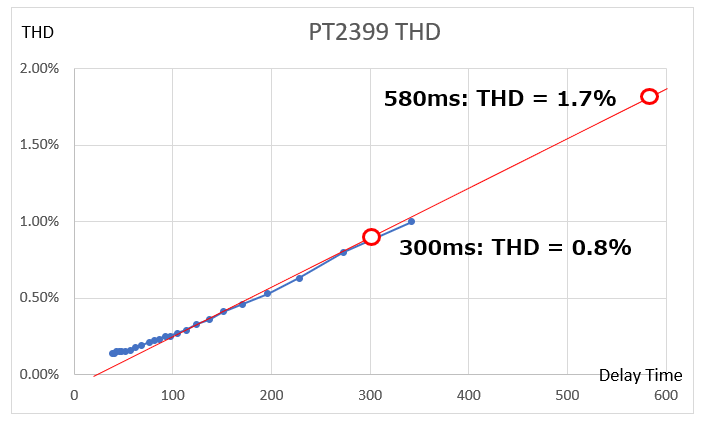
Incorporating into an enclosure
To install it in the enclosure, I first installed the phone jack, switch, and DC jack to be placed under the board, and after wiring, I installed the PCB with the pot.
If the guitar is directly connected to the input line, the impedance will be high, making it susceptible to noise. To prevent this, a thin shield wire is used. The outputs are buffered and low impedance so no shielding is required.
Finished with a sticker
For the enclosure, I used a HAMMOND 1590N1 compatible product. Until now, I used the painted one (about $15) and it was expensive, but this time the compatible one (purchased at GarrettoAudio, 70N1) was half the price ($7).
The longest delay time is 600ms, so I named it "ANALOG DELAY 600" and made it a plum color (dark wine red). I designed it with PowerPoint and printed it on a dedicated sticker sheet with an inkjet printer.
It is an unpainted enclosure, but when I put a sticker on it, the retro feel increases and it looks good.
Lastly
When I was little, delay pedals were too expensive to buy. Delay pedals were my favourite, so I made four delay pedals myself. BBD has many adjustment points, and it may be difficult without an oscilloscope to produce a clean sound. On the other hand, this PT2399 has no adjustment, so I think it is easy to make by yourself.
The internals of the PT2399 are digitally processed, but the sound output is close to BBD (cheap, not HiFi), and I think it's suitable for guitar pedals. There are many self-made examples of PT2399, but please select it as one of them. Coolaudio's V571 seems to be handled only by "Akizuki Denshi Tsusho" in Japan. Due to the shortage of semiconductors during the corona crisis, it may be difficult to obtain, so if you want to try it, hurry up!
Language
Self-made
effect pedals
- Pedals list page
 Tool selection
Tool selectionVEMURAM Jan Ray
Xotic BB preamp
Klon Centaur
 Revived old Chorus
Revived old Chorus MXR Envelop Filter
MXR Envelop Filter BBD Analg Delay DM-3
BBD Analg Delay DM-3 600ms Analog Delay
600ms Analog Delay Arduino Analog Delay
Arduino Analog Delay BBD Analg Chorus CE-3
BBD Analg Chorus CE-3CMOS Octaver OC-2
 Riot using chip parts
Riot using chip parts Original design noise gate
Original design noise gate EP & MICRO AMP duo
EP & MICRO AMP duo Keeley 4 Knob Comp
Keeley 4 Knob Comp MXR Phase 90 MOD
MXR Phase 90 MOD Keeley Blend Comp
Keeley Blend Comp DM-3 longer delay time
DM-3 longer delay time ISP Decimator V2164
ISP Decimator V2164


